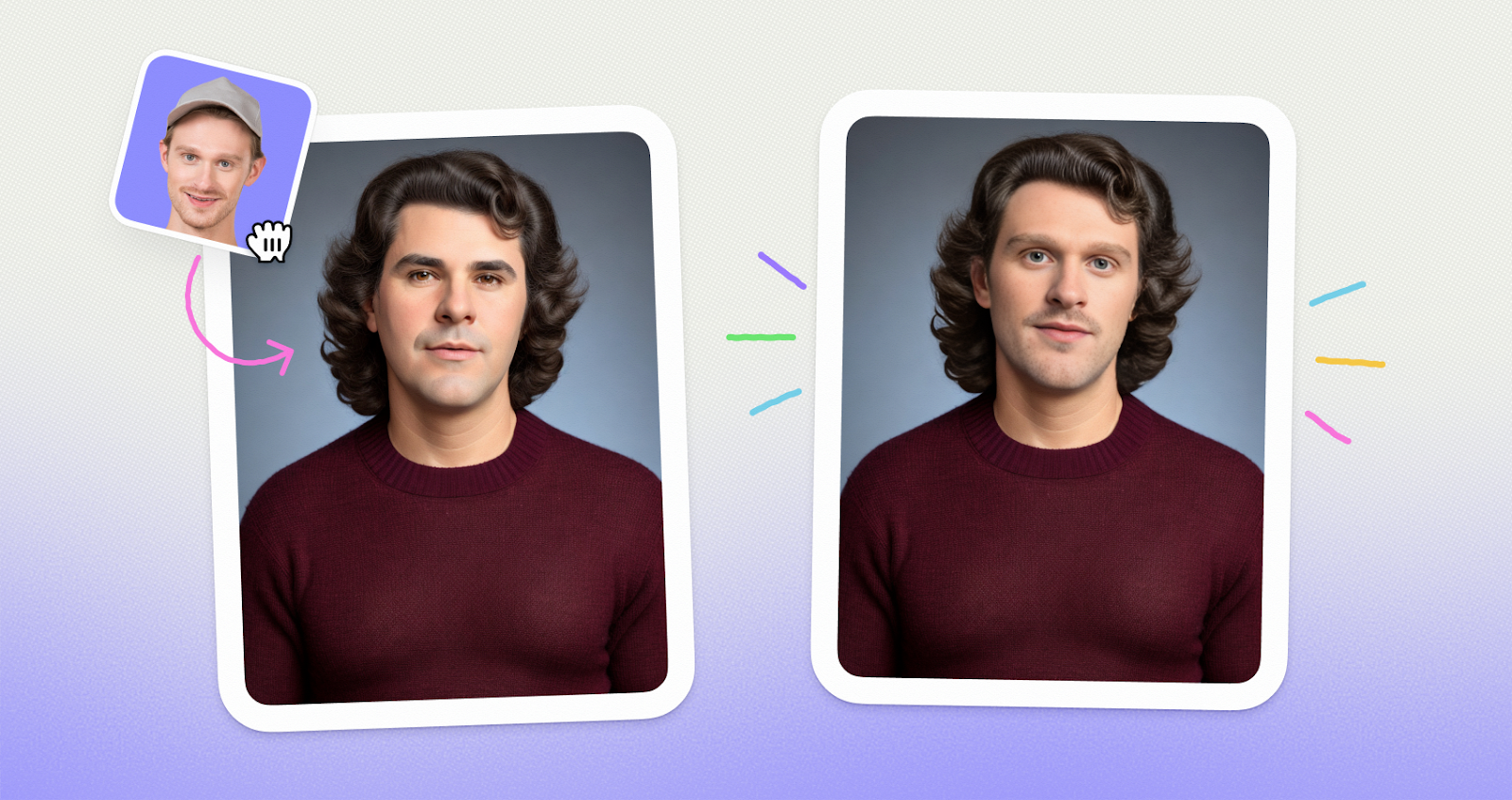
So you’ve heard about face swapping tech and wondering if Icons8’s version is worth your time? I’ve been testing this thing for a while now, and honestly, the results are mixed. Some stuff works great, other parts… not so much. Let me break it down for you.
Alright, here’s the deal with how this works. Icons8 uses some fancy neural network stuff that’s been trained on thousands of face photos. The system spots around 68 different points on faces – think corners of eyes, tip of nose, edges of lips. Pretty standard stuff, really.
But here’s where it gets interesting (and where they actually do something right): instead of just finding these points and slapping faces together like some amateur Photoshop job, it analyzes how light hits faces, studies skin textures, and figures out color patterns. That’s why results don’t scream “FAKE!” at you.
You can upload files up to 5MB, works best when faces are around 1024×1024 pixels. Everything runs on their servers, so it doesn’t matter if your computer is from this decade or the last one. And surprisingly, your photos don’t come back looking like they went through a meat grinder – quality stays pretty good.
Where People Actually Use This Thing
Design Work (The Good Stuff)
I know a few designers who’ve made this part of their regular workflow. Instead of hiring different models every time they need to test how something looks with different demographics, they just shoot once and adapt. Smart move, honestly – saves money and headaches.
Talked to one creative director who uses it for client presentations. She stopped trying to explain abstract concepts and just shows clients what campaigns might look like with different target audiences. Clients get it immediately instead of nodding along while secretly confused.
Design students are having a field day with this. They’re experimenting with facial proportions, seeing how different features work in layouts, and using tools like an AI image generator to create dynamic visuals for their projects. It’s like having unlimited reference photos without paying model fees or dealing with scheduling nightmares.
Marketing Shenanigans
Marketing teams have gotten creative here. Take a campaign shot in, say, San Francisco, and adapt it for markets in Tokyo or Lagos by swapping faces to match local demographics. The cost savings compared to shooting everything multiple times? Huge.
Some companies test concepts before dropping serious cash on final photography. They create mockups with different demographic characteristics, run them past focus groups, see what sticks. It’s risk management, basically.
Social media managers love this for platform-specific content. What works on Instagram might need tweaking for LinkedIn or TikTok. Instead of starting from scratch, they just adapt existing stuff.
Photography Problems (And Solutions)
Wedding photographers – bless their hearts – have found salvation here. You know that one person in every group photo who blinks or makes a weird face? Yeah, that problem is basically solved now. No more trying to coordinate 30 relatives for “just one more shot.”
Corporate event photographers deal with similar nightmares. Getting a room full of executives to all look professional simultaneously is like herding cats. Now they can capture several versions and pick the best expressions later.
Portrait studios use it during consultations. Clients can see how they might look with different styling before committing to a full session. Cuts way down on post-session complaints and reshoot requests.
App Development and UX Stuff
App developers have worked this into their prototyping process. Need diverse user imagery for testing? Just modify existing photos instead of hunting down new ones for every demographic category you want to represent.
UX teams test interface designs with different user types by creating representative imagery. Beats making assumptions about how diverse users might react to visual elements.
Mobile app teams especially dig this for app store materials. You need diverse representation in screenshots and promotional content, but coordinating model releases and casting calls is a pain. This sidesteps all that bureaucracy.
Features That Don’t Suck
Multiple Faces at Once
The ability to process six faces simultaneously isn’t just showing off – it’s genuinely useful for group scenarios. What’s impressive is how everything stays realistic. Lighting remains consistent, perspective makes sense, nobody looks like they were badly cut and pasted from different photos.
Complex group situations work better than expected. People overlapping, different distances from camera, various angles – the system handles these scenarios pretty well. Not perfect, but good enough for most professional use.
Beyond Basic Mugshots
This isn’t limited to straight-on passport photos. Three-quarter angles, slight tilts, even some profile shots can be processed successfully. That flexibility matters when you’re doing creative work that needs dynamic compositions instead of boring corporate headshots.
The way it adapts proportions to match existing head positioning is actually pretty clever. These technical details separate convincing results from obvious fakes that make people cringe.
Keeping Personalities Intact
The system preserves what makes faces distinctive – bone structure, unique features, overall proportions. It’s not erasing someone’s personality; it’s moving it thoughtfully from one context to another.
Expression preservation works well too. Original emotions and facial dynamics carry through, which matters for professional work where authenticity counts for something.
Performance Reality Check
Quality and Resolution
The 1024-pixel ceiling works fine for web stuff and most digital marketing. Print work might hit some walls, but for typical professional uses, quality stays decent. Detail preservation and color accuracy meet most client expectations – though don’t expect miracles.
Quality stays fairly consistent across different starting materials. Whether you begin with professional studio shots or decent smartphone photos, output standards remain predictable. Key word: predictable, not necessarily amazing.
Speed and Reliability
Processing times stay reasonable for most professional deadlines. Multi-face scenarios take longer (obviously), but rarely long enough to mess up project flow. Cloud processing means your hardware doesn’t become the limiting factor.
Being web-based has clear advantages – no software to install, update, or troubleshoot. Teams working across different systems appreciate this simplicity, especially when dealing with client reviews and approvals.
Getting Your Team Started
The Learning Curve
Some universities are building this into their curricula – not just as a tech tool but as a way to discuss AI ethics and responsible use. Students get hands-on experience while developing critical thinking about digital manipulation.
The learning curve isn’t brutal, but understanding best practices makes a significant difference. Teams that invest in proper training see much better results than those who just wing it and hope for the best.
Business Integration
Service providers find it valuable for client consultations. Showing examples instead of just describing possibilities improves communication and project outcomes dramatically.
Project managers build it into planning for campaigns needing demographic diversity. Resource allocation becomes more predictable when you can modify existing imagery instead of planning multiple expensive shoots.
Organizations exploring faceswap technology should consider both technical capabilities and workflow requirements. Web access provides flexibility, but understanding connectivity needs and processing limits prevents unpleasant surprises down the road.
Privacy and Doing This Right
Data Security Stuff
The platform uses secure storage with clear policies about data retention. Users control their upload history and can delete content when needed. These controls matter when handling sensitive client materials or personal information.
Data handling follows standard cloud practices with transparency about storage and access procedures. This helps organizations make informed decisions about adoption within their existing security frameworks.
The Ethics Talk
Face Swapper includes guidance about appropriate uses and potential problems. Professional users need this information for developing internal policies about responsible technology deployment.
Questions around consent, representation, and responsible application become important as teams integrate these tools into business workflows. Clear guidelines help prevent problematic implementations that could cause legal or PR headaches.
Money Talk (The Important Part)
Budget Reality
Subscription pricing eliminates per-project fees while providing predictable costs for budget planning. Different tiers accommodate various needs without forcing teams into oversized plans they don’t actually need.
Compared to traditional photography and retouching costs, the economics work out pretty well. Time savings and reduced revision cycles often justify subscription costs quickly – though your mileage may vary.
Productivity Gains
Automated processing cuts manual work significantly compared to traditional methods. Teams report faster turnaround for client revisions and concept iterations, which translates into happier clients and better profit margins.
Efficiency improvements come from streamlined workflows and better client communication. Visual examples reduce miscommunication and those endless revision cycles that drive everyone up the wall.
Making It Work in Reality
Integration Planning
Success requires thinking through how this fits into existing processes. Teams need clear protocols for quality control, file management, and processing optimization. Don’t just throw this into your workflow and hope it works.
Training on optimal image selection and processing techniques ensures consistent results across different team members. Understanding requirements upfront prevents quality problems that show up when it’s too late to fix them.
Quality Control
Professional work demands consistent standards regardless of who handles processing. Testing protocols and benchmarks help maintain quality across different projects and clients.
Documentation of what works and what doesn’t supports team knowledge sharing. This systematic approach improves results while reducing the learning curve for new team members.
Where This Tech Is Headed
Future Development
Face swapping keeps evolving through better algorithms and processing improvements. Applications are expanding beyond creative fields into training, education, and business contexts that we probably haven’t thought of yet.
Integration with other creative tools suggests growing professional adoption. This trend points toward more seamless workflow opportunities, though implementation will probably remain messy for a while.
Market Position
The platform competes in a crowded space, but technical capabilities and pricing position it reasonably well among web-based solutions for professionals who don’t need extreme complexity or bleeding-edge features.
Demand for accessible AI tools keeps growing as creative professionals seek workflow improvements without major technical investments or steep learning curves that eat into billable hours.
The Stuff That Doesn’t Work
Technical Limitations
The 5MB file limit requires optimization for high-resolution workflows. Quality depends heavily on input characteristics – lighting, clarity, positioning all matter way more than you’d expect.
Web-based operation means connectivity dependencies that could mess up urgent projects. Teams should plan backup workflows for critical situations or unreliable internet connections.
Quality Dependencies
Results vary dramatically with input preparation. Understanding lighting requirements, angle limitations, and resolution needs helps achieve consistent outputs. Garbage in, garbage out – this rule applies here too.
The platform works within specific parameters that won’t fit every professional requirement. Knowing these boundaries prevents disappointment and helps with realistic project planning.
Bottom Line
Icons8 Face Swapper delivers decent neural network-based face replacement through accessible web processing. It addresses real needs across design, marketing, photography, and development while staying usable for professionals without deep technical backgrounds.
Success depends on understanding both capabilities and limitations. Teams need clear policies, quality standards, and proper training for effective implementation. It’s not magic – it’s a tool that requires thoughtful use.
The platform sits reasonably well within the current AI tool landscape, offering practical capabilities at fair pricing. It requires thoughtful deployment that balances creative opportunities with professional responsibilities. For teams that get this balance right, it opens up useful possibilities that weren’t available before – just don’t expect miracles.
Raghav is a talented content writer with a passion to create informative and interesting articles. With a degree in English Literature, Raghav possesses an inquisitive mind and a thirst for learning. Raghav is a fact enthusiast who loves to unearth fascinating facts from a wide range of subjects. He firmly believes that learning is a lifelong journey and he is constantly seeking opportunities to increase his knowledge and discover new facts. So make sure to check out Raghav’s work for a wonderful reading.




